Java并发工具类---ForkJoin、countDownlatch、CyclicBarrier、Semaphore
一、Fork Join
fork join是JDK7引入的一种并发框架,采用分而治之的思想来处理并发任务
ForkJoin框架底层实现了工作窃取,当一个线程完成任务处于空闲状态时,会窃取其他工作线程的任务来做,这样可以充分利用线程来进行并行计算,减少线程竞争。但是在某些情况下也会存在竞争。
Fork Join框架局限性:
1.拆分任务中不应该去执行IO操作
2.任务不能检查抛出异常,必须通过必要的代码来抛出异常。这个在源码中就可以体现,很多地方都是通过代码主动抛出异常。
3.任务只能使用Fork和Join操作来进行同步机制,如果使用了其他同步机制,则在同步操作时,工作线程就不能执行其他任务了。比如,在Fork/Join框架中,使任务进行了睡眠,那么,在睡眠期间内,正在执行这个任务的工作线程将不会执行其他任务了。
Demo:
ForkJoin进行累加计算
public class MakeArray {
public static final int ARRAY_LENGTH=4000;
//获取一个随机数的数组
public static int[] makeArray(){
Random r=new Random();
int[] res=new int[ARRAY_LENGTH];
for(int i=0;i<ARRAY_LENGTH;i++){
res[i]=r.nextInt(ARRAY_LENGTH*3);
}
return res;
}
}
public class SumArray {
private static class SumTask extends RecursiveTask<Integer>{
private final static int THRESHOLD=MakeArray.ARRAY_LENGTH/10;
private int[] src;
private int fromIndex;
private int toIndex;
public SumTask(int[] src, int fromIndex, int toIndex) {
this.src = src;
this.fromIndex = fromIndex;
this.toIndex = toIndex;
}
@Override
protected Integer compute() {
if(toIndex-fromIndex<THRESHOLD){
//无需再拆分
int count=0;
for(int i=fromIndex;i<=toIndex;i++){
try {
TimeUnit.MILLISECONDS.sleep(1);
count+=src[i];
} catch (InterruptedException e) {
throw new RuntimeException(e);
}
}
return count;
}else{
int mid=(fromIndex+toIndex)/2;
SumTask left=new SumTask(src,fromIndex,mid);
SumTask right=new SumTask(src,mid+1,toIndex);
invokeAll(left,right); //执行任务,把任务添加到队列,该方法中执行了fork
return left.join()+right.join(); //合并结果
}
}
}
public static void main(String[] args) {
int[] src=MakeArray.makeArray();
ForkJoinPool pool=new ForkJoinPool();
SumTask innerFind=new SumTask(src,0,src.length-1);
long start=System.currentTimeMillis();
pool.invoke(innerFind);
System.out.println("The count is "+innerFind.join()+" spend time:"+(System.currentTimeMillis()-start)+" ms");
}
}
运行结果:

采用单线程进行对比:
public class SumNormal {
public static void main(String[] args) {
int count=0;
int[] src=MakeArray.makeArray();
long start=System.currentTimeMillis();
for(int i=0;i<src.length;i++){
try {
TimeUnit.MILLISECONDS.sleep(1);
count+=src[i];
} catch (InterruptedException e) {
throw new RuntimeException(e);
}
}
System.out.println("The count is "+count
+" spend time:"+(System.currentTimeMillis()-start)+"ms");
}
}

二、countDownlatch
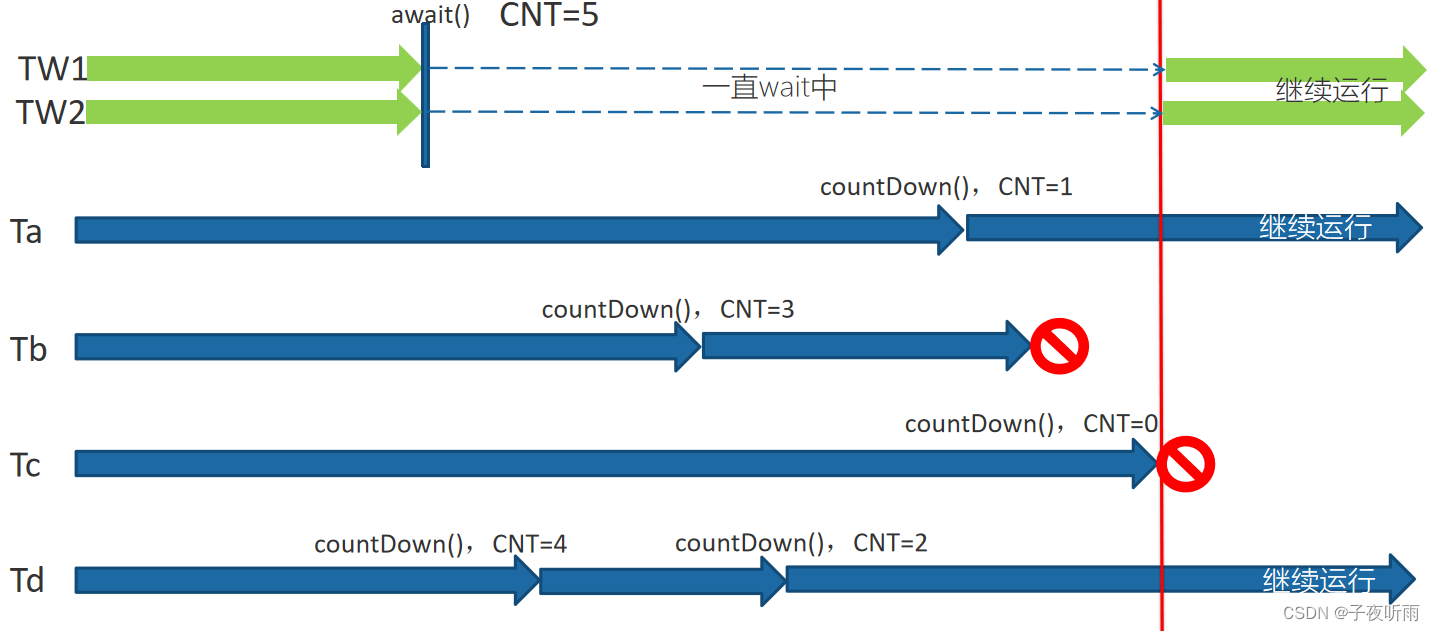
countDownlatch也是一个java的同步工具类,它通过计数器来控制线程的执行顺序。初始化时需要初始化计数器的值,一般都是线程数量。每当一个线程执行完任务,计数器减一,当计数器为0,等待的线程就可以恢复执行任务。
需注意: 计数器的值不一定就是线程数量,线程中可以多次调用countDown来使计数器减一。
执行减一操作后,线程不一定要终止,也可以继续执行任务(如上图Ta,Td)。
Demo:
public class UseCountDownLatch {
//计数器设置为6
static CountDownLatch latch=new CountDownLatch(6);
private static class InitThread implements Runnable{
@Override
public void run() {
System.out.println("Thread_"+Thread.currentThread().getId()+
" ready init work...");
//计数器减1
latch.countDown();
for(int i=0;i<2;i++){
System.out.println("Thread_"+Thread.currentThread().getId()
+"......continue do its work");
}
}
}
private static class BusiThread implements Runnable{
@Override
public void run() {
try {
//在此处会阻塞,当计数器扣减为0时会被唤醒
latch.await();
} catch (InterruptedException e) {
throw new RuntimeException(e);
}
for(int i=0;i<3;i++){
System.out.println("BusiThread_"+Thread.currentThread().getId()
+" do business----");
}
}
}
public static void main(String[] args) {
new Thread(new Runnable() {
@Override
public void run() {
try {
TimeUnit.MILLISECONDS.sleep(1);
System.out.println("Thread_"+Thread.currentThread().getId()+
" ready init work step 1st...");
latch.countDown();
System.out.println("begin step 2nd....");
TimeUnit.MILLISECONDS.sleep(1);
System.out.println("Thread_"+Thread.currentThread().getId()
+" ready init work step 2nd...");
latch.countDown();
} catch (InterruptedException e) {
throw new RuntimeException(e);
}
}
}).start();
new Thread(new BusiThread()).start();
for(int i=0;i<=3;i++){
new Thread(new InitThread()).start();
}
try {
latch.await();
System.out.println("Main do ites work ...");
} catch (InterruptedException e) {
throw new RuntimeException(e);
}
}
}
运行结果:
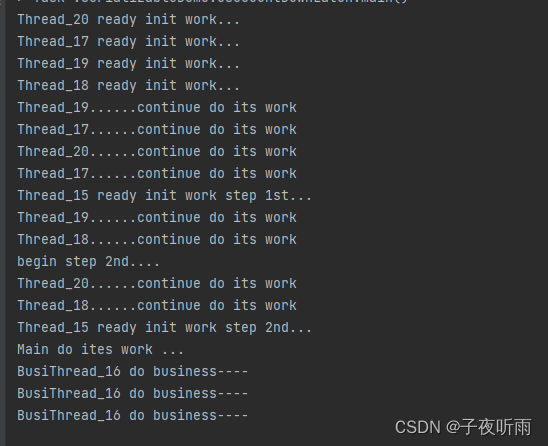
三、CyclicBarrier
CyclicBarrier可以实现让一组线程达到一个屏障(Barrier)时被阻塞,当所有线程都到达屏障时,被阻塞的线程才会继续执行
Demo:
public class UseCyclicBarrier {
//屏障拦截四个线程,当屏障放开时,会执行传入的CollectThread
private static CyclicBarrier barrier=new CyclicBarrier(4,new CollectThread());
//存储子线程的工作结果
private static ConcurrentHashMap<String,Long> resultmap
=new ConcurrentHashMap<>();
public static void main(String[] args) {
for(int i=0;i<=3;i++){
new Thread(new SubThread()).start();
}
}
private static class CollectThread implements Runnable{
@Override
public void run() {
StringBuilder res=new StringBuilder();
for(Map.Entry<String,Long> r:resultmap.entrySet()){
res.append("["+r.getValue()+"]");
}
System.out.println("the result ="+res);
}
}
private static class SubThread implements Runnable{
@Override
public void run() {
long id=Thread.currentThread().getId();
resultmap.put(Thread.currentThread().getId()+"",id);
System.out.println("Thread_"+id+"...do something");
try {
//在此处被屏障拦截,当屏障放开后才会继续执行
barrier.await();
System.out.println("Thread_"+id+"...do its business");
} catch (InterruptedException e) {
throw new RuntimeException(e);
} catch (BrokenBarrierException e) {
throw new RuntimeException(e);
}
}
}
}
结果:
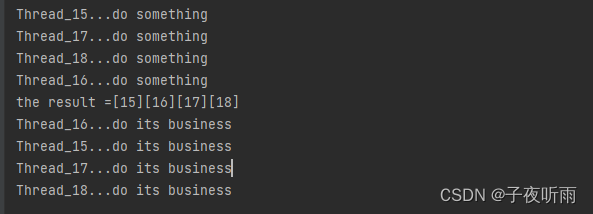
四、Semaphore
Semaphore的中文翻译就是信号量,是用来进行流量控制的,可以协调各个线程合理的使用资源。
new Semaphore(10) 来创建一个信号量,值为10,这里会创建一个非公平的锁的同步阻塞队列。
acquire方法信号量-1 release方法信号量+1 信号量为0时再执行acquire就会阻塞,直到信号量不为0时(其他线程执行了release)才会继续运行
1.Semaphore实现连接池
注意,实现连接池时需要用两个Semaphore,因为通过release归还时,信号量会超出10个的限制
public class DBPoolSemaphore {
private final static int POOL_SIZE=10;
//可用连接和已用连接
private final Semaphore useful,useless;
//存放数据库连接的容器
private static LinkedList<Connection> pool=new LinkedList<>();
public DBPoolSemaphore() {
this.useful=new Semaphore(10);
this.useless=new Semaphore(0);
for(int i=0;i<POOL_SIZE;i++){
pool.addLast(SqlConnectImpl.fetchConnection());
}
}
//归还连接
public void returnConnect(Connection connection) throws InterruptedException {
if(connection!=null){
System.out.println("There are now"+useful.getQueueLength()+"threads waiting to connection "+
"useful connection:"+ useful.availablePermits());
useless.acquire();
synchronized (pool){
pool.addLast(connection);
}
useful.release();
}
}
//获取连接
public Connection getConnect() throws InterruptedException {
useful.acquire();
Connection connection;
synchronized (pool){
connection=pool.removeFirst();
}
useless.release();
return connection;
}
}
public class AppTest {
private static DBPoolSemaphore dbPool=new DBPoolSemaphore();
private static class BusiThread extends Thread{
@Override
public void run() {
Random r=new Random();
long start=System.currentTimeMillis();
try {
Connection connection= dbPool.getConnect();
System.out.println("Thread_"+Thread.currentThread().getId()+
"get db connection use time:"+(System.currentTimeMillis()-start)+"ms");
TimeUnit.MILLISECONDS.sleep(100+r.nextInt(100)); //模拟业务操作
System.out.println("task completion,return connection");
dbPool.returnConnect(connection);
} catch (InterruptedException e) {
throw new RuntimeException(e);
}
}
}
public static void main(String[] args) {
for(int i=0;i<50;i++){
Thread thread=new BusiThread();
thread.start();
}
}
}
运行结果:

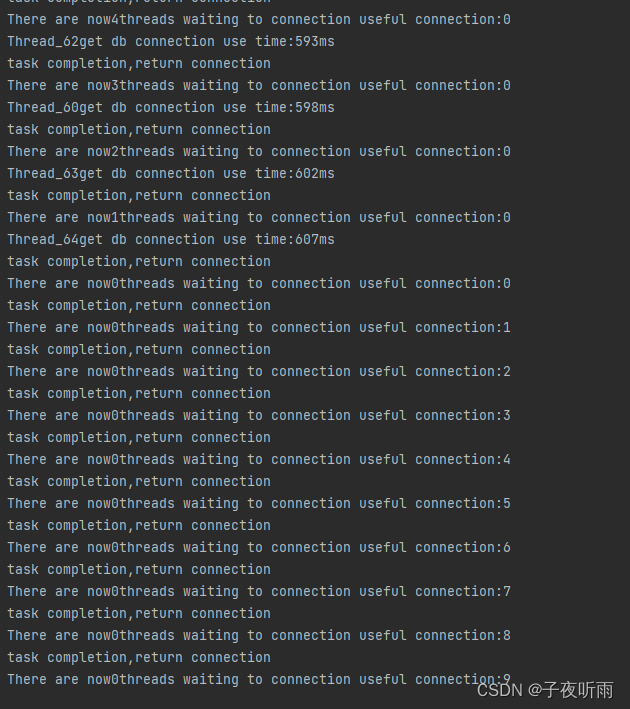
2.思考
使用双信号量是为了防止信号量会超过10个的限制,如果按如下的方法调用连接池:
public class AppTest {
private static DBPoolSemaphore dbPool=new DBPoolSemaphore();
private static class BusiThread extends Thread{
@Override
public void run() {
Random r=new Random();
long start=System.currentTimeMillis();
try {
// Connection connection= dbPool.getConnect();
// System.out.println("Thread_"+Thread.currentThread().getId()+
// "get db connection use time:"+(System.currentTimeMillis()-start)+"ms");
// TimeUnit.MILLISECONDS.sleep(100+r.nextInt(100)); //模拟业务操作
// System.out.println("task completion,return connection");
dbPool.returnConnect(new SqlConnectImpl());
} catch (InterruptedException e) {
throw new RuntimeException(e);
}
}
}
public static void main(String[] args) {
for(int i=0;i<50;i++){
Thread thread=new BusiThread();
thread.start();
}
}
}
在线程中,只归还连接,归还的是自己new出来的连接。如果此时是单信号量只有useful,那么useful会变成60个:
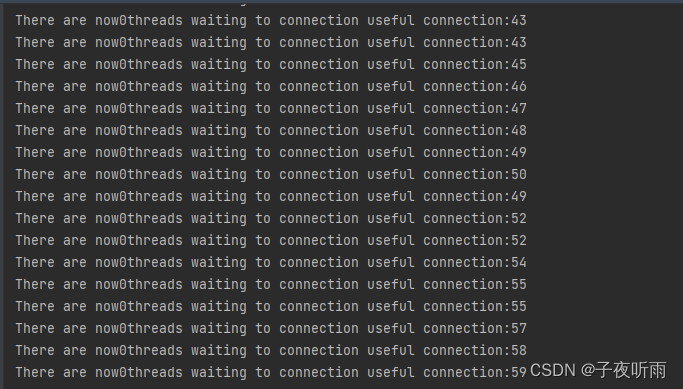
//单信号量
public void returnConnect(Connection connection) throws InterruptedException {
if(connection!=null) {
System.out.println("There are now"+useful.getQueueLength()+"threads waiting to connection "+
"useful connection:"+ useful.availablePermits());
synchronized (pool) {
pool.addLast(connection);
}
useful.release();
}
}
如果采用两个信号量,因为useless一开始为0,所以没有get连接直接归还连接时,会在useless.acquire那里阻塞住,可以有效的防止上面情况的发生。
//双信号量
public void returnConnect(Connection connection) throws InterruptedException {
if(connection!=null){
System.out.println("There are now"+useful.getQueueLength()+"threads waiting to connection "+
"useful connection:"+ useful.availablePermits());
System.out.println("1");
useless.acquire(); //useless一开始为0.直接调用returnConnect会在这里阻塞住
System.out.println("2");
synchronized (pool){
pool.addLast(connection);
}
useful.release();
}
}

log中并没有2,归还连接时被阻塞在useless.acquire
总之,双信号量可以有效的防止可用连接溢出的情况发生。个人感觉,如果是实现一个线程池,线程池中的连接不能让用户通过new SqlConnectImpl()这种形式new出来,SqlConnectImpl应该是对用户不可见的。对于用户来说,应该只能通过getConnect来从线程池获取连接,这样或许也能够避免这种问题出现。
本文来自互联网用户投稿,该文观点仅代表作者本人,不代表本站立场。本站仅提供信息存储空间服务,不拥有所有权,不承担相关法律责任。 如若内容造成侵权/违法违规/事实不符,请联系我的编程经验分享网邮箱:veading@qq.com进行投诉反馈,一经查实,立即删除!